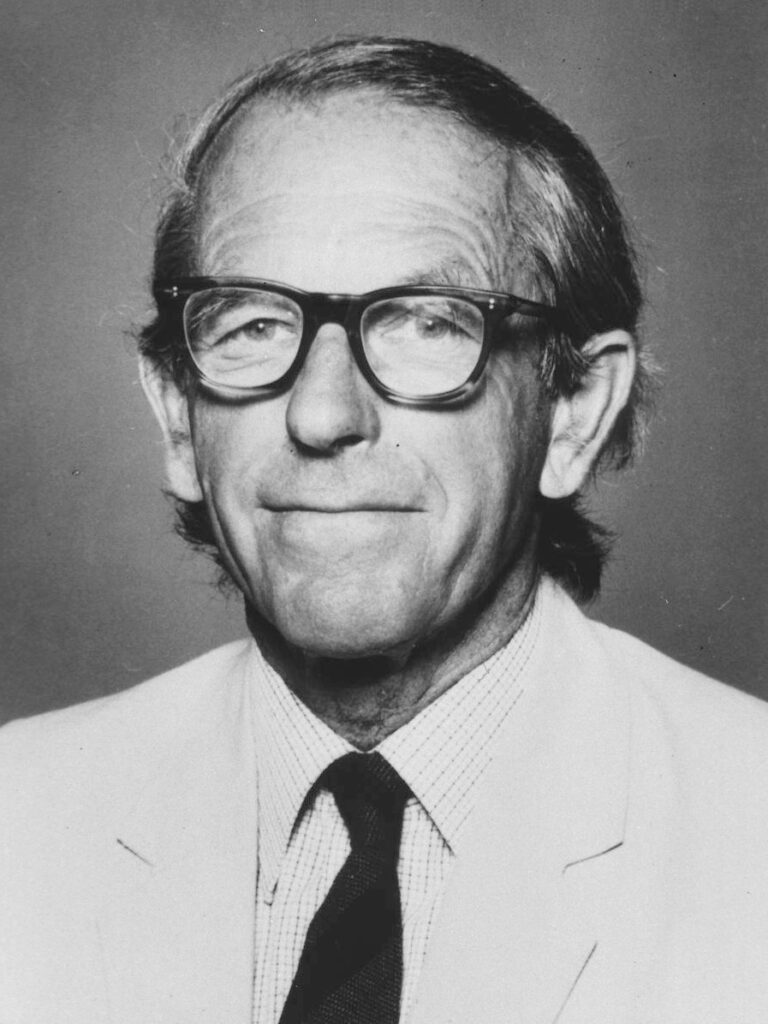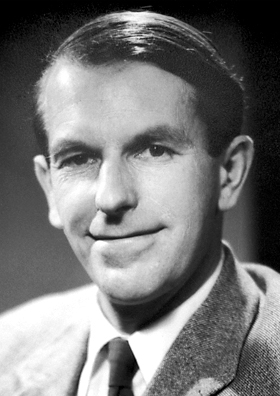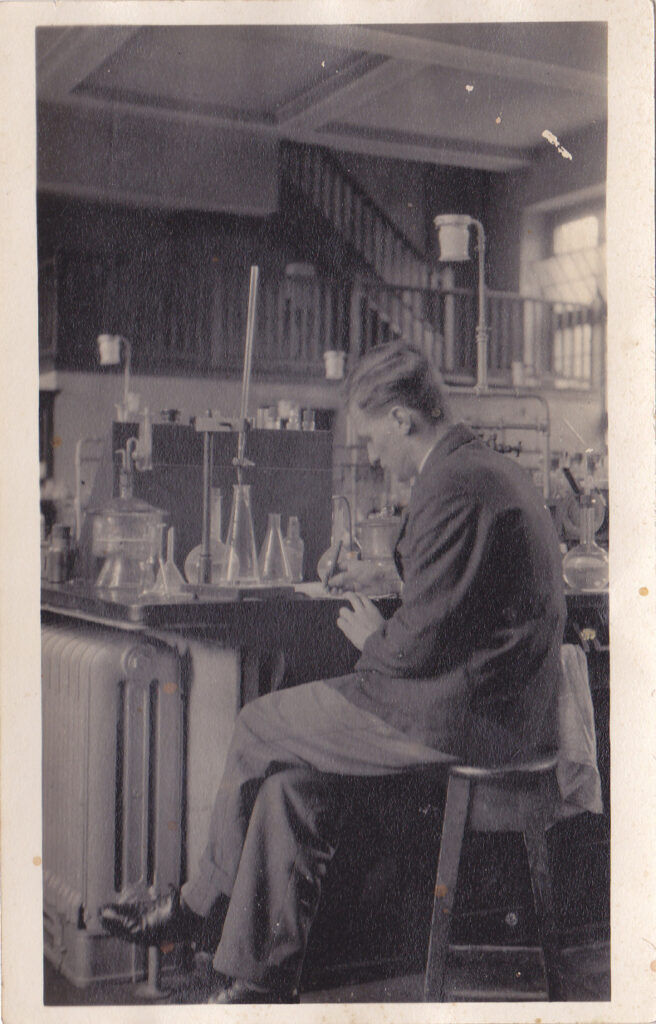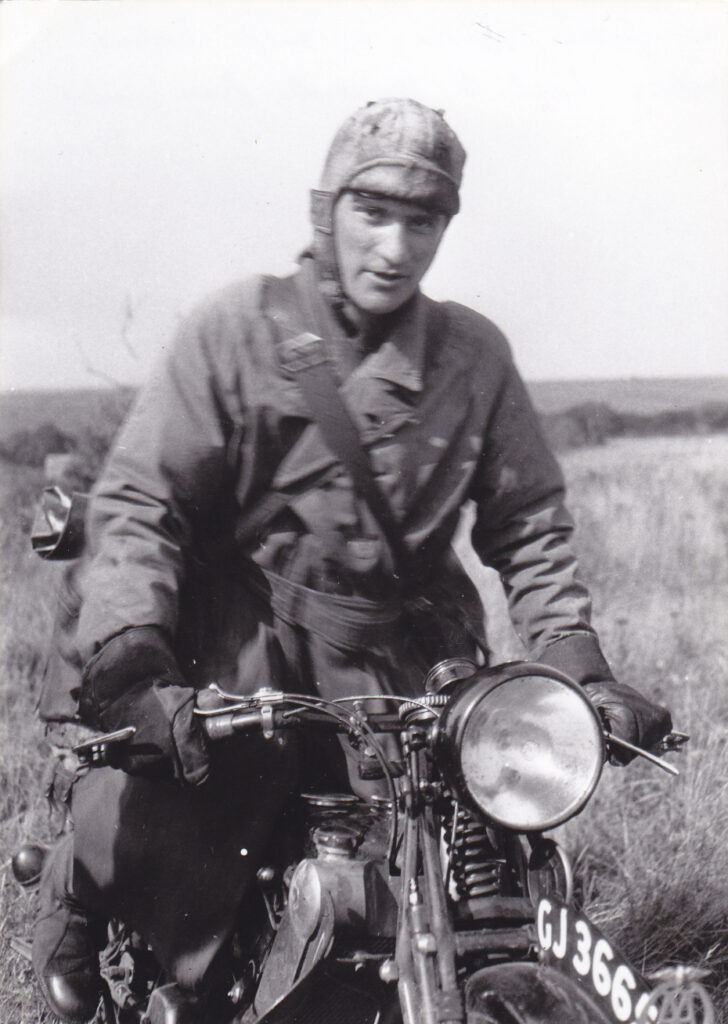Frederick Sanger might not be a household name, but it’s a rare household today that doesn’t have him to thank for saving the life of a loved one. Sanger’s painstaking, labor-intensive research advanced the scientific community’s understanding of insulin in leaps and bounds. His research completely revolutionized the everyday lives of diabetics all over the world.
His contributions to science never went unnoticed, and Sanger was awarded a rare honor: he’s one of the few scientists to receive more than one Nobel Prize, an achievement that puts him in the same rare air as some of the biggest scientific names of the 20th century: Marie Curie, John Bardeen, and Linus Pauling. You might think an achievement like that takes nothing short of complete dedication and unrivaled research, study, and work, but Sanger had a different approach.
During his 1958 acceptance speech for the Nobel prize, he advised listeners to simply figure out what it was they were passionate about, then “follow those dreams as far as possible, and try and do that thing that really interests you, and you feel is really worthwhile.”
That was Sanger’s secret. He often referred to what he did as “messing about at the lab bench,” and said that he “got his kicks out of doing experiments.” He was so successful, simply because he was honestly invested in the research and interested in what he was doing.
When he was awarded his second Nobel Prize in 1980, Hanger said, “I believe that we have been doing this not primarily to achieve riches or even honor, but rather because we were interested in the work, enjoyed doing it, and felt very strongly that it was worthwhile.”
While we learned a lot from Sanger’s work, we stand to learn just as much from his outlook on life.

Follow Your Passion
It wasn’t always Frederick Sanger‘s goal to follow the path that would lead him to two Nobel Prizes. Originally, he had planned on following in the footsteps of his father, also named Frederick.
Frederick the elder was born in 1876 to a well-off family. After graduating from Cambridge with a medical degree, he headed off to China on a trip sponsored by the Church Missionary Society as a medical missionary. He spent 10 years there before returning and settling in Gloucestershire, where he married the daughter of a wealthy cotton merchant.
Cicely Crewdson was a quiet, shy young woman, devoted completely to her family. That would come to include sons Theodore and Frederick and daughter Mary. The three children enjoyed a peaceful, happy childhood, first in Rendcomb, then in Tanworth-in-Arden. They moved to the latter, near Birmingham, when Sanger was just five years old, and the quaint town left a lasting impression.
First, there was religion. When his parents married, Frederick the Elder abandoned his Anglican heritage to become a Quaker. At the heart of Quaker beliefs is the idea that every single person carries a bit of the divine within them, and each life contains equal value. Each person is special and touched by God in their own unique way, so members of the Quaker community tend to devote themselves to secular issues of social justice, freedom, human rights, environmentalism, and peace — beliefs that we’ll return to in our tale.
For now, it’s enough to say that young Sanger’s childhood was shaped by these beliefs, even though his mother and her family — the reason his father had converted in the first place — eventually turned back to the Church of England. Still, the children faithfully recited daily prayers and attended regular Quaker meetings, and after their move, they brought another major influence into their home: a Quaker governess named Helen Mary Shewall. She taught the Sanger children as well as a few others in the neighborhood, and it was here he first discovered his innate love of science natural history.
From attending a Quaker boarding school to a Doset public school, Sanger thrived… but only in a particular kind of environment, and that was one where students were allowed to explore and discover things for themselves. It was while he was studying at Bryanston, between 1932 and 1936, that he met two teachers who would have a profound impact on him.
First, there was Frazer Hoyland, the biology teacher, who would let students just sort of muck about in his laboratory after school; Sanger was captivated by the slides his teacher would prepare for him to look at under the microscope. Then, there was the chemistry teacher, Geoffrey Ordish. Ordish had done considerable research on dyes during his own university years, and gave Sanger his first practical research project: make colored crystals.
Sanger would later write: “working in the lab was a marvelous change for me, from just sitting and studying books. I decided this was something I really enjoyed.”
For most of his life — up until his final year at Bryanston — his family fully expected that Frederick the Younger was going to follow in his father’s footsteps and become a doctor. His teachers changed that, though, and opened him up to a whole new world of possibilities. He would write: “Although I would have liked to be able to relieve people’s suffering it seemed to me to be a very scrappy sort of job, continually running from one problem to another, whereas I preferred the idea of having a single problem I could really get my teeth into.”
It was a case of perfect timing: as Sanger was enrolling in Cambridge and picking his classes, one that was fairly new popped up on the register. It was biochemistry — even the term itself had only been around a few decades, first coined in 1903. It was the ideal combination of the two sciences that had interested him most in his other schools, and he would later remember: “… the idea that living matter could be explained in terms of chemistry seemed exciting and to open up all sorts of possibilities.”
That, it most certainly did.
A Brilliant Young Mind in a Brilliant Young Science
At first, Sanger’s schooling didn’t go terribly well. This is potentially explained by several terrible tragedies. In 1937, his father underwent an operation to treat his stomach cancer and passed away. Only a year later, his mother passed away after being diagnosed with colon cancer. Dealing with the death of his parents was difficult enough, and he was juggling classes at Cambridge at the time, as well — classes like physics and mathematics that he not only didn’t like, but that he had been vastly underprepared for.

At this time, there was another vast event that not just Sanger, but the whole world was preparing for: World War 2. On September 3, 1939, Britain declared war on Germany, and soon after, it passed conscription laws. Any men between the ages of 18 and 41 who were deemed medically fit, and who were not occupied in key industries like medicine or farming, were required to register for military service.
Recall that Sanger grew up with Quaker beliefs that held all lives were of equal value. Naturally, Sanger was a pacifist, and so he appeared before a military tribunal to argue his case against his own conscription. Not only was awarded conscientious objector status, but he also met his future wife, Joan Howe, who he married in 1940.
That’s not to say he didn’t contribute to the war effort. He spent a good amount of time at a work camp in Devon, and by the time he returned to Cambridge, one of the department researchers offered him a project connected to the war effort. The team was working on nutrition-related problems; specifically, they were researching lysine metabolism and the nitrogen content of the potato. Sanger ultimately wrote a paper on it, and it earned him his PhD… eventually — he had to go back and correct the spelling mistakes first.
Nobel Prize #1
One of the researchers who had overseen Sanger’s PhD research was Albert Charles Chibnall, a biochemist already well-known for his work in investigating the chemistry of insect and plant waxes, as well as his research on plant proteins. By the time Sanger finished his PhD, Chibnall had taken over at Cambridge as the Sir William Dunn Professor of Biochemistry. He also organized a research group to work on a few problems. Don’t worry, this isn’t going to turn into the sort of science you need a PhD to understand.
The basic problem was this: scientists knew that the human body’s proteins were made up of combinations of different amino acids — they’re the things you would have heard called “the building blocks of life” in rudimentary science classes. What these guys didn’t know was how many different amino acids there were, and how they combined to form proteins.
With Chibnall’s guidance, Sanger set about working on mapping the amino acids in insulin — and there were a few reasons he chose this particular thing to research. For one, it was available in large quantities, and was regularly sourced from cattle. It was a pure protein that was, in itself, fairly small, and he also knew that research into insulin would provide valuable insight into diseases like diabetes. Strangely, attempts to get funding for his work failed repeatedly. Even though Sanger and Chibnall believed each protein had a regular, well-defined, and consistent structure, while most of their colleagues subscribed to the school of thought that the molecules were too complex or too random to be sequenced. That made getting funding for their work into something of an uphill battle, but Sanger wasn’t about to give up on this particular challenge.

Ultimately, he went about finding the order of these particular building blocks in a pretty neat way, a method that was basically akin to doing a jigsaw puzzle in reverse. He took the intact polypeptide chains of insulin, colored the ends with a yellow dye, then broke the whole thing down into its composite amino acids. The ones with the dye? Those were the amino acids that were on the ends. From there, it was a matter of tagging those fragments in order and repeating the process, so he could isolate the next group of amino acids, and finally come up with an order that was the same in every sample of insulin.
It wasn’t just his work with insulin that proved important — the compound he used to dye those fragments became known as Sanger’s reagent, and it’s still used when working with small proteins. It’s not just dye, either — the method he developed to sequence the building blocks of amino acids has been used in numerous other proteins.
It’s difficult to stress just how important a discovery this was. The method has been described as a sort of Rosetta Stone for understanding our own biochemistry, and that of literally every living thing around us. Once we knew the methods, we could unlock, translate, and understand other proteins — just as cracking the code of an ancient alphabet might allow us to translate all other works written in that language.
It wasn’t until 1955 that Sanger discovered how the individual chains were linked, and it was this work with insulin that led to his Nobel Prize in Chemistry in 1958. This wasn’t just mucking about with obscure theories and practices in a laboratory — it changed medicine forever. If anyone you know has diabetes, and relies on insulin to manage their condition, that wouldn’t be possible without Sanger’s work. It was only after he deconstructed naturally occurring insulin that we knew how to construct synthetic insulin.
Additionally, the same principles at work here have been used in numerous other medical treatments. He may not have followed in his father’s footsteps and gotten his medical degree, but he’s still helped people across the world and saved an indeterminate number of lives.
The Building Blocks of Humanity
Sanger described the time following his work with insulin as “The Lean Years,” when he was wrapping up his work on insulin and trying to figure out what was going to come next. He had suspected he was going to keep working with insulin, but added, “I have always been rather unsuccessful in predicting the future, especially in my own research. … the sequencing bug had already taken hold of me.”
Even as Sanger was working on sequencing the building blocks of insulin, there was another scientist also looking at the smallest elements of what makes us who we are: our DNA. Francis Crick made the jump from physics to biology in 1947, and in 1953, he made the first proposal of the double helix structure for DNA that we’re all familiar with today. Afterwards, he went on to research just how information was transferred from DNA to RNA, which are the structures responsible for building proteins. Crick and his research team were interested in how molecular structures could contain genetic information, and their proposals came just at the right time for Sanger to get involved in this new field of research.

In 1962, Sanger capitalized on the growing influence that his recent successes had given him, and transferred to Cambridge’s newly opened Medical Research Council Laboratory of Molecular Biology. It was there that he was tasked with doing something similar to his work with insulin, but with DNA: determining what order the bases of DNA were assembled in. In modern times, it’s what we now call DNA sequencing.
In hindsight, Sanger has said that they had no way of knowing that they were embarking on a project that would ultimately lead to the sequencing of the entire human genome. It may have been their wildest dreams, but how often do dreams become reality? Especially when they had some massive problems to overcome, some of which had nothing to do with science — they once again had trouble getting funding, mostly because the researchers were in for the long haul. This project had no chance of a fast result, no quick solutions. When it came to financing, it was difficult to get someone to invest in something that wouldn’t come to fruition for years.
And it did take a long time. It wasn’t until 1971 that cutting-edge technology allowed for the sequencing of DNA to just 12 base components. Sanger continued his work, and by 1978, he had sequenced a strand of DNA to 5,286 bases. By 1982, the number had risen to 48,502.
That huge jump came because in 1977, Sanger had perfected a new method of sequencing nucleic acids. Like a lot of the science Sanger worked around, it’s extremely complicated. Put in basic terms, a strand of DNA is used as a template, and researchers attempt to grow a second strand by adding one of the four possible bases, one at a time. Eventually, the wrong base gets added and growth stops, allowing them to compare this “wrong” version of the strand to the right one. If a scientist were to repeat this process for long enough, he or she would eventually have a complete picture of the original, correct order of acids.
And that’s the basis of his 1980 Nobel Prize, which he shared with fellow researchers Paul Berg and Walter Gilbert.
What happened after that was essentially out of his hands. Caltech biologist Leroy Hood gathered together a group consisting of a chemist, a computer scientist, and an engineer. They sat down, took Sanger’s sequencing work, and looked at ways they could automate it with up-and-coming technology… and they did. By 1987, the first robotic sequencers were built, and they were capable of reading around 5,000 base pairs a day. Fast forward a bit, and today, automatic sequencers can read tens of billions of pairs in a single day.
Stepping aside and making way
Here’s the most surprising thing: Sanger was 62 when he was awarded his second Nobel Prize, and that’s still pretty young — especially considering that he was working in a field that he loved, doing work he absolutely enjoyed, surrounded by colleagues he liked and respected. But even though he probably could have gotten any post he wanted, researching anything he chose, he had already decided that at 65, he was going to retire.
In one of his few writings that doesn’t deal solely with his work, he explained: “I had not thought about retirement until I suddenly realized that in a few years I would be 65, and would be entitled to stop work and do some of the things I had always wanted to do and had never had time for. The possibility seemed surprisingly attractive…”
At the time he was writing, he was looking back on the decision, and was doing so with no regrets. He was happy to step aside for a younger scientist, he wrote, to give someone from the next generation of researchers his place on the bench. He had done his work, and now, it was time to see where it went, guided by the next group of scientists and researchers.
He officially retired in 1983, and any time he was asked about his accomplishments he remained almost shockingly modest. Two years after he retired, he was interviewed about his success and said, “A lot of it was luck. … I’ve had a lot of good ideas, but most of them haven’t worked.” He continuously downplayed his own work, and at the same time, attributed his success to those around him — all brilliant and enthusiastic researchers, he was always sure to note.
Fortunately, he was able to see those who followed in his footsteps take off with his work, saying in a later article that while he was thrilled that his methods were still the methods used and that his work had been a major contribution to medical science, there were some things about this future of sequencing that he didn’t approve of.
In part, he frowned on the decision of some groups working on DNA sequencing who had decided not to make their research publicly available — that, he said, went against all the reasons he had gotten involved in science in the first place. He wrote, “The genome is a vital part of us all, probably the most vital, and information about it should be freely available and must not become the private property of anyone, however rich. No other part of the human body has ever been committed to such selfish conditions, and it seems completely immoral to try to place restrictions on such a vital part of humanity.”
Sanger went on to decline a knighthood, saying that he just didn’t want to be called “Sir”. He did accept an Order of Merit, though, and gave his name to the Sanger Centre in Cambridge — the place that would become the home of the Human Genome Project. He remained content to watch others take the fruits of his hard work and run with it — he spent his remaining years preferring to spend his time in his gardens instead of the limelight, although he remains “the father of genomics.” He wasn’t afraid to say that he believed the science of sequencing DNA had quickly outpaced him — he claimed that he wouldn’t be fond of modern research, or spending his time sitting in front of a computer… although he regularly popped into the institute that bore his name, just to see what was going on.
And it was a lot. His work has had widespread impact, from understanding diabetes to diagnosing diseases that have a genetic level, it’s Sanger who we can thank for establishing the building blocks of it all.
In 2001, the Human Genome Project released a groundbreaking paper that included the draft sequence for 90 percent of the human genome, something which they called a genetic blueprint for a person. It contained a massive amount of information that will likely take even more decades to completely understand. Since then, researchers have made discoveries like the so-called “junk DNA” that appears to serve no practical purpose at this stage in our evolution, but might give us invaluable clues to our evolutionary past. They’ve found strange, repeated sequences, science still needs to unlock the mysteries of human DNA… at least, though, we have the pages and the letters — thanks to Fred Sanger.
And fortunately, he lived to see it. Sanger passed away peacefully in 2013, at the age of 95. In spite of his repeated insistence that he was not “academically brilliant,” the countless people whose lives he has saved would probably say differently.



